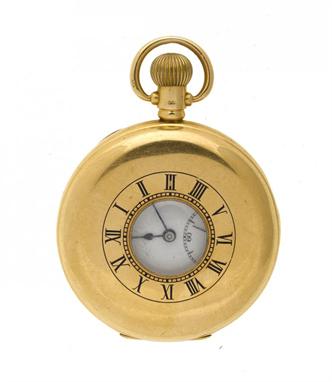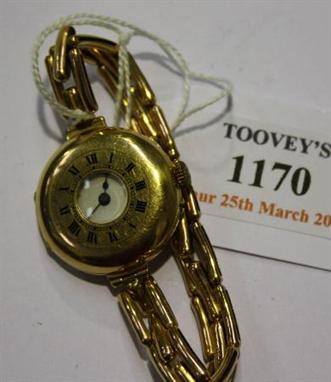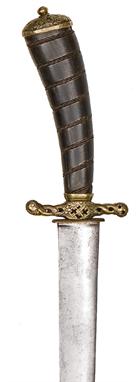We found 74922 price guide item(s) matching your search
There are 74922 lots that match your search criteria. Subscribe now to get instant access to the full price guide service.
Click here to subscribe- List
- Grid
-
74922 item(s)/page
AN OMEGA 9CT GOLD KEYLESS LEVER HUNTING CASED WATCH the movement numbered 5957220, the dust cap engraved with an inscription and date 9th April 1927, Birmingham 1924++In good second hand condition and going order although sold without warranty in this respect. Note: dented in once place on the band
HUNTING AND RACING. THE EDWARDIAN AUTOGRAPH MANUSCRIPT HUNTING DIARY OF THE HONOURABLE WILLIAM REGINALD WYNDHAM 1907-10 Seasons, with full accounts of days hunting with various packs, in particular the Duke of Rutland`s, copiously illustrated with quarter plate [100 x 140mm] photographs, invitations, press cuttings, mainly relating to Wyndham`s success as a breeder of racehorses, written in ink, 276p (200 x 160mm), some autograph letters tipped in, quarter tan morocco gilt (split) t.e.g., c1910 Captain the Hon. William Reginald Wyndham (1876-1914) was the third son of Henry Wyndham, 2nd Baron Leconfield. He served in the South African War but returned to service in 1914 as a Captain in the Lincolnshire Yeomanry attached to the 1st Life Guards. He was killed in action on 6 November 1914 and left an estate of £325,000. 516. WORLD WAR TWO. THE AUTOGRAPH MANUSCRIPT WAR DIARY OF THOMAS CLORAN, RAF WHEN A PRISONER OF WAR IN STALAG LUFT VII written in soft pencil (subsequently carefully written over in black ink by his wife) in a Wartime Log for British Prisoners issued by the YMCA, 116 pages (170 x 120mm) illustrated with drawings of camp life and his German identity card, an account of his bailing out of a burning Lancaster over France, capture and arrival at the camp, followed by occasional entries from 22 August 1944-22 April 1945 and the following few days, the last two leaves with details of his fellow allied prisoners, with his group of three campaign medals comprising 1939-1945 Star, Air Crew Europe Star and War Medal, in franked card box of issue, a wristwatch and album of press cuttings An extraordinary account of life in Stalag Luft VII in the closing months of the war. Thomas Henry Cloran (1913-1981) volunteered for the RAF in 1939. He was the navigator on board a blazing Lancaster bomber over France and bailed out at 02.15 hrs on 31 May 1944. Before doing so he noticed another of the crew who was crouching in the aircraft`s nose and had no parachute. Although both men were severely burned, Cloran told him to cling to his waist and they would jump together. Tragically the man eventually lost his grip and fell to his death. Two French women sheltered Cloran but, realising that he needed life saving treatment, handed him over to a German medical unit. In later life Cloran sought out the surviving woman, then of great age, who had been ostracised by her village in the mistaken belief that she had collaborated with the Germans over his arrest. A deeply religious man, he was born at Royton, Lancashire and as a young man moved to Bletchley, Herfordshire where he managed a butcher`s shop for the local Co-Op. Stalag Luft VII was opened in 1944 in what is now Poland. In September of that year the 230 RAF crew were joined by men captured at the Battle or Arnhem. On 19 January 1945, with the approach of the Red Army the Germans marched the by then 1500 prisoners, including Cloran, west, crossing the Oder and on 5 February put them on a train to Stalag III-A. There 20,000 allied prisoners were liberated by the Russians.
A copper and nickel hunting horn engraved ` Will Goodall Belvoir Kennels`,the maker`s name Schott & Co. 159 Regent Street, London to the reverse. 8 7/8 in longand a leather horn case.The horn is thought to have belonged to Will Goodall`s son `Young Will Goodall` the renown huntsman to the Pytchley and probably presented to him as a young man while serving as whipper-in at the Belvoir in 1870 as a promising young huntsman to be.Will Goodall remained at the Belvoir under Frank Gillard until 1874 when he was enticed away to become Huntsman to the Pytchley under Lord Spencer.Like his father young Will Goodall was devoted to his hounds and his hounds to him and was renown for dismounting and making a fuss of his hounds.Young Will became joint master of the Pytchley in 1890, and five years later in 1895 was struck down by a fatal illness and died. It was said by Harry Bentley that for twenty two years he had been the very spirit of the hunt and wrote a poem in Memorandum.The horn was purchased at auction in Harare, Zimbabwe almost two years ago and thought to have found its way from the UK through hunting connections to the Belvoir.
19th century painted leather three-fold fire screen, the arched central panel painted with a woman on horseback being startled by a hunting party with hounds, the sloping side panels decorated with trees, 25.75" high x 48" wide (leather a.f); together with a decorative four-fold bedroom screen, each panel with an arched top, upholstered on one side in green velvet, the other side with chinoiserie fabric, 68.5" high x 72" wide (2)
A late Victorian Elkington & Co. plated novelty hunting interest cruet set, modelled as a horseshoe shaped stand with spur handle surmounted by a boot shaped pepper and mustard, a riding hat salt and a horn shaped spice pot with spoon, together with two spoons with whip handles, height approx 9cm.
A Glow-Worm gilt metal cased keyless wind open-faced gentleman`s pocket watch, a silver cased keyless wind open-faced gentleman`s pocket watch, Birmingham 1901, a gilt metal keyless wind hunting cased gentleman`s pocket watch, with a gilt metal watch Albert chain, four open-faced pocket watches, a German keyless wind hunting cased lady`s fob watch, a silver curblink watch Albert chain, and a slide action pencil with spiral decoration.
A late 17th century silver mounted hunting hanger, slightly curved, shallow hollow ground blade 19½”, DE for half its length, brass inlaid maker’s mark of 3 stars with tails, ornamental crossguard with turn down ball quillon engraved with flowers, lower band and pommel engraved with strawberries and leaves, pommel cap part HM lion, and HH (?) monogram, 2 piece staghorn grip. QGC (¼” of blade tip and knucklebow missing)
An interesting hunting sword, evidently a conversion of a French cavalry officer’s sword c 1785, captured during the Napoleonic wars, broad, slightly curved shallow fullered blade 29½”, with a little original scroll etching towards the forte, the back of the blade removed and the edge saw backed for most of its length, gilt double shell and loop guard with knucklebow, the sidebars removed, cap shaped pommel, leather grip (most wire missing) inside of guard engraved with English owner’s initials “WH”, in its leather scabbard with long brass chape and leather locket; see Wagner “Cut and Thrust Weapons” p 311 and Blair “European and American Arms” p 103(b) for similar originals. Basically GC, the hilt retaining approx 15% original gilt (some wear overall, hilt a little misshapen and one loop broken)
EPHEMERA (12): An early leather and EPNS hip flask with decorative cup, a silver plated hip flask 60z size with stamps to base, a modern leather covered hip flask, all three with screw tops, a Royal Worcester bone china fishing/hunting cup and saucer with maker`s box and eight whiskey glasses with an assortment of engraved flies and leaping fish, Property of Victory Bonney, London and George Bonney (his nephew).
AFTER LIONEL EDWARDS "The Grafton. Weedon Bushes", colour print from The Hunting Countries Series, printed and published by Eyre & Spottiswoode, signed in pencil, bears studio stamp and old labels verso, one inscribed "Vicar`s Brothers Dealers in High Class Paintings and Drawings, Print Sellers and Publishers, 12 Old Bond Street, London W"
-
74922 item(s)/page







![CECIL CHARLES WINDSOR ALDIN, RBA (1870-1935) [HUNTING SCENES] a pair, offset lithographs, both signed by the artist in the ma](http://lot-images.atgmedia.com/SR/10086/2790905/536-2010312173232_468x382.jpg)
































